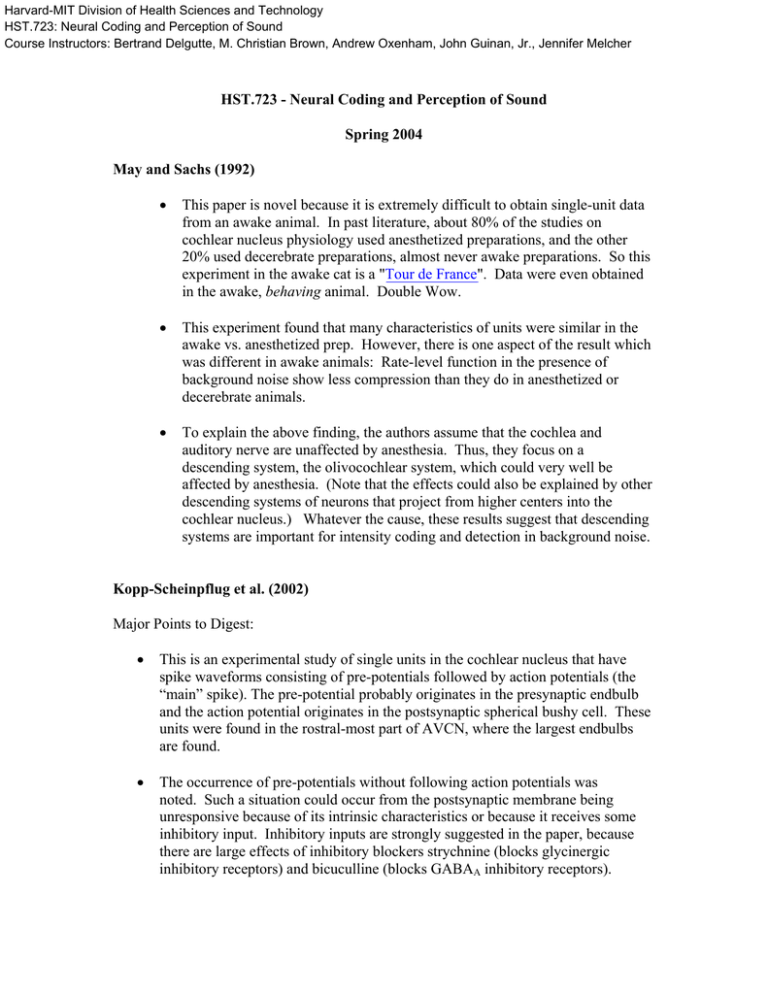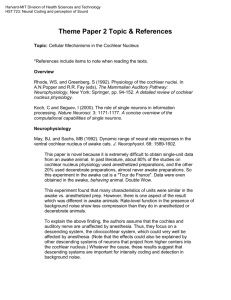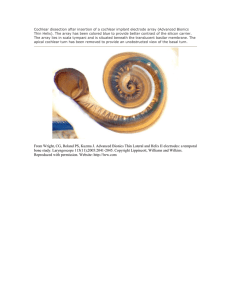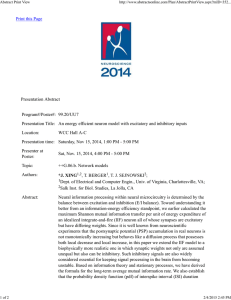Harvard-MIT Division of Health Sciences and Technology
advertisement

Harvard-MIT Division of Health Sciences and Technology HST.723: Neural Coding and Perception of Sound Course Instructors: Bertrand Delgutte, M. Christian Brown, Andrew Oxenham, John Guinan, Jr., Jennifer Melcher HST.723 - Neural Coding and Perception of Sound Spring 2004 May and Sachs (1992) • This paper is novel because it is extremely difficult to obtain single-unit data from an awake animal. In past literature, about 80% of the studies on cochlear nucleus physiology used anesthetized preparations, and the other 20% used decerebrate preparations, almost never awake preparations. So this experiment in the awake cat is a "Tour de France". Data were even obtained in the awake, behaving animal. Double Wow. • This experiment found that many characteristics of units were similar in the awake vs. anesthetized prep. However, there is one aspect of the result which was different in awake animals: Rate-level function in the presence of background noise show less compression than they do in anesthetized or decerebrate animals. • To explain the above finding, the authors assume that the cochlea and auditory nerve are unaffected by anesthesia. Thus, they focus on a descending system, the olivocochlear system, which could very well be affected by anesthesia. (Note that the effects could also be explained by other descending systems of neurons that project from higher centers into the cochlear nucleus.) Whatever the cause, these results suggest that descending systems are important for intensity coding and detection in background noise. Kopp-Scheinpflug et al. (2002) Major Points to Digest: • This is an experimental study of single units in the cochlear nucleus that have spike waveforms consisting of pre-potentials followed by action potentials (the “main” spike). The pre-potential probably originates in the presynaptic endbulb and the action potential originates in the postsynaptic spherical bushy cell. These units were found in the rostral-most part of AVCN, where the largest endbulbs are found. • The occurrence of pre-potentials without following action potentials was noted. Such a situation could occur from the postsynaptic membrane being unresponsive because of its intrinsic characteristics or because it receives some inhibitory input. Inhibitory inputs are strongly suggested in the paper, because there are large effects of inhibitory blockers strychnine (blocks glycinergic inhibitory receptors) and bicuculline (blocks GABAA inhibitory receptors). • The paper reports the several ways in which the pre-synaptic activity differs from the postsynaptic activity, which is a measure of how inhibition has changed the response of the cochlear nucleus neuron vs. its auditory-nerve input. We don’t know the exact function of such inhibitory input nor do we know its exact origin. This is a good example of what neuroscientists are currently working on in the auditory brainstem. Kalluri and Delgutte (2003) • This paper describes a computational model of onset cells in the cochlear nucleus. These cells are interesting because their response patterns to tone bursts strikingly differ from those of their auditory-nerve (AN) inputs. In addition, onset neurons, unlike AN fibers, tend to entrain to low-frequency tones, i.e. fire exactly once per stimulus cycle. • A strength of the model is its simplicity: it has only a half dozen free parameters, yet it simulates a wide range of onset-cell response properties. Specifically, two key simplifying assumptions are made: • It is a point neuron model, meaning that all points inside the cell are assumed to be at the same potential. This assumption is appropriate for electrical small cells that have short, thick dendrites, so that the attenuation of membrane voltage along the dendrites is minimal. In contrast, neuron models that simulate the voltage distribution along dendrites are called compartment models. • The active membrane channels giving rise to actions potentials are not modeled explicitly; rather a phenomenological threshold-crossing model with a refractory period is used. This means that the model can only predict spike times, not spike waveforms. • Results show that it is relatively easy to simulate Onset response patterns to tone bursts if the model has (1) a short membrane time constant, and (2) many, weak synaptic inputs. In these conditions, temporal coincidence of action potentials from many AN inputs is necessary to elicit an output spike, a condition that only arises at stimulus onset. However, the model has trouble entraining to low-frequency tones if it must fire only once at the onset of high-frequency tone bursts. It is argued that a more complex spiking mechanism is needed to produce the short interspike intervals needed for entrainment, while preventing these short intervals with high-frequency stimulation. • An analytical coincidence detector model is used to understand some aspects of the computational model. An important insight of this analytical model is the importance of fluctuations in membrane voltage for producing spikes, even if the mean depolarization caused by the synaptic inputs remains constant. Such fluctuations (and therefore steady-state discharge rate) can be reduced by having many, weak synaptic inputs.





